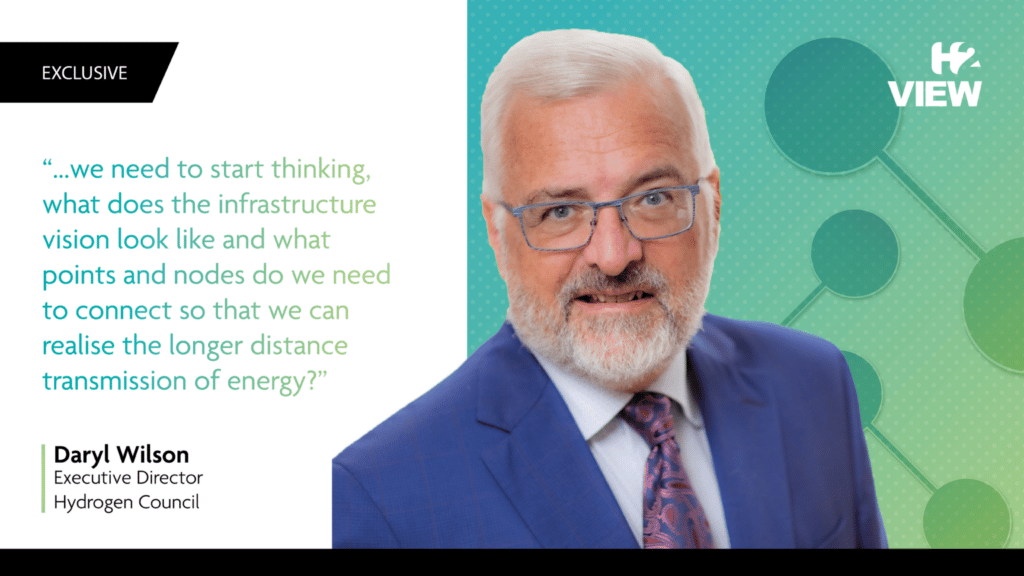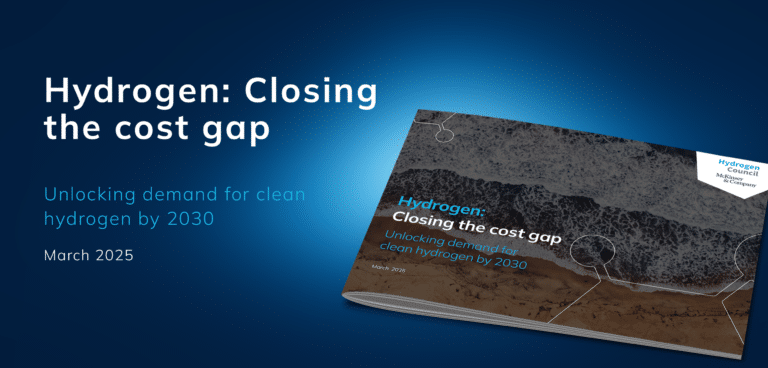This interview by Rob Cockerill was first published in H2 View.
The momentum in hydrogen investments and deployment has been building for many years and has rapidly accelerated since 2020, but we’re now seeing the bigger picture in hydrogen unveiled and the direction of the task ahead.
Connecting the dots in infrastructure, renewable energy hubs and demand centres will be the focal point in unlocking hydrogen’s undoubted potential.
That’s according to Daryl Wilson, Executive Director of the Hydrogen Council, speaking to H2 View upon the release of the new Global Hydrogen Flows report.
Released in the last few minutes and co-authored by McKinsey & Company, the report combines the global industry data from the Hydrogen Council with a bespoke advanced-analytics optimisation model, specifically developed for the study, that balances supply and demand across all regions, multiple carriers, end products and scenarios.
It finds that while helping to accelerate the transition to Net Zero, long-distance and international hydrogen trade flows can reduce the total system costs across the hydrogen value chain by as much as $6 trillion.
There will still be a requirement for around $150bn of investment by 2030 to realise hydrogen’s role in the energy transition, rising to up to $1.5 trillion by 2050.
Wilson acknowledges these are still ‘staggering’ figures, noting for perspective that these investments are both in proportion to current energy system spending and an element of them will be a replacement component as spending migrates from old to new infrastructure investment.
It is the point around infrastructure, however, that Wilson believes is the key finding from the report – and the big reveal in terms of the bigger picture in hydrogen going forward.
“I think the contribution of this report is very important in pointing toward the whole notion of infrastructure,” he told H2 View. “We’ve certainly moved over the last few years from demonstration projects to clusters of projects in valleys and ports. There’s been a good scaling-up step that’s happened with the big clusters of projects in these hydrogen hubs. That’s a very strong concept.
“But hubs need to be interconnected into a full infrastructure system to serve the energy needs in any particular region, and that means pipelines and interconnected renewables and electrolyser business. I think we’re beginning to see where those infrastructure investments need to be made, and the approximate pace to make those happen. Naturally, planning corridors for electrical transmission networks and pipelines takes many, many years.”

Out of 1.5 million potential trade routes, the report identifies more than 40 prospective trade routes of hydrogen (or hydrogen equivalent derivatives), with the capacity to transport more than one million tonnes per annum by ship or pipeline.
The study identifies distinct patterns for hydrogen trade. Pure hydrogen is expected to be a ‘regional’ business and will be predominantly sourced domestically or piped from nearby regions, and only shipped via a carrier (ammonia, liquid hydrogen or LOHC) if the prior options are not available.
However, hydrogen derivatives including ammonia for end use, methanol, synthetic kerosene and direct reduced iron will be shipped around the world given relatively low transportation costs, compared to production costs.
The evolution of hydrogen trade flows is expected to take place in four distinct phases, beginning with hydrogen derivative shipping by 2025, followed by the emergence of long-distance hydrogen pipelines by 2030, shipping and pipeline reaching scale by 2040, and a fully mature traded market by 2050.
“It’s important that we start to have a grand vision, that we need to go from point A to point B,” Wilson explained, likening the task ahead to conversations during a recent event he attended in Pittsburgh in the US, where the building of the current highway system across the US was discussed.
“When the vision was cast in the 1950s to generate the interstate highway system, there was a clear plan to go from one city to another and interconnect various corridors. In a similar manner with hydrogen, we need to start thinking, what does the infrastructure vision look like and what points and nodes do we need to connect so that we can realise the longer distance transmission of energy?
“Our current energy system travels over many, many kilometres and that’s going to be true in the new energy system. We need to connect sources of renewable energy with demand centres for hydrogen. And so, long-distance transmission and pipelines is certainly going to be a major factor – and then shipping corridors as well.”
Wilson is pragmatic in terms of the scale and nature of that challenge ahead, adding, “The sector has to grow up to learn how to engage infrastructure money in an intelligent way and offer the risk profile that goes with lower returns. This is the next challenge and there’s a fair bit of work in preparation for that to happen.
“We need to see the success of the hydrogen hubs and valleys. We need to see the technology scaling and operating. All of these things will give confidence to lenders that this is indeed a mature sector that can scale into that infrastructure level of finance.”
‘Charging the funnel’
While the report paints the picture for the future infrastructure landscape in hydrogen, it’s clear that the momentum is behind hydrogen as 2022 draws to a close – and the Hydrogen Council is happy with the brushstrokes that have already been applied to the energy canvas.
Wilson describes activity to date as charging the funnel at the front end, with the task now to overcome any impasse in final investment decisions (FIDs) and permitting of projects.
“We’re now tracking 648 projects and around $240bn in investment,” he enthused. “So the numbers keep going up. And it’s indicative of a rapidly growing sector where there’s lots of announcements, and then the work of getting these projects over the line into final investment decision and into build takes some time.
“We’re charging the funnel in the front end with a lot of announcements, and then the flow through is taking a bit of time. But that’s not a negative situation, it’s a normal situation, with such a rapid growth in the sector.
“It’s an exciting, busy time and there’s lots of work ahead of us to implement all these projects, whether it’s getting the final investment decision through, the funding lined up, the actual procurement, or the build stage and the permitting.
“There are many, many steps to bring the project across the line and it’s going to take some time for all of this to come to fruition. But the front end of the funnel is charging nicely with a lot of activity.”



